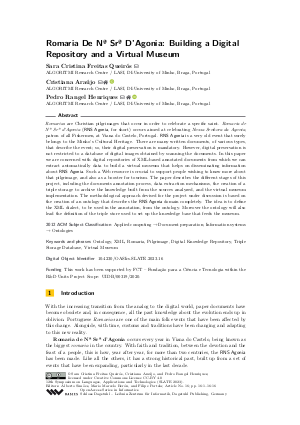Romaria De Nª Srª D'Agonia: Building a Digital Repository and a Virtual Museum
Authors
Sara Cristina Freitas Queirós,
Cristiana Araújo  ,
Pedro Rangel Henriques
,
Pedro Rangel Henriques 
-
Part of:
Volume:
12th Symposium on Languages, Applications and Technologies (SLATE 2023)
Part of: Series: Open Access Series in Informatics (OASIcs)
Part of: Conference: Symposium on Languages, Applications and Technologies (SLATE) - License:
 Creative Commons Attribution 4.0 International license
Creative Commons Attribution 4.0 International license
- Publication Date: 2023-08-15
File

PDF
OASIcs.SLATE.2023.16.pdf
- Filesize: 3.34 MB
- 16 pages
Document Identifiers
Subject Classification
ACM Subject Classification
- Applied computing → Document preparation
- Information systems → Ontologies
Keywords
- Ontology
- XML
- Romaria
- Pilgrimage
- Digital Knowledge Repository
- Triple Storage Database
- Virtual Museum
Metrics
- Access Statistics
-
Total Accesses (updated on a weekly basis)
0PDF Downloads0Metadata Views
Abstract
Romarias are Christian pilgrimages that occur in order to celebrate a specific saint. Romaria de Nª Srª d'Agonia (RNS Agonia, for short) occurs aimed at celebrating Nossa Senhora da Agonia, patron of all Fishermen, at Viana do Castelo, Portugal. RNS Agonia is a very old event that surely belongs to the Minho’s Cultural Heritage. There are many written documents, of various types, that describe the event; so, their digital preservation is mandatory. However, digital preservation is not restricted to a database of digital images obtained by scanning the documents. In this paper we are concerned with digital repositories of XML-based annotated documents from which we can extract automatically data to build a virtual museum that helps on disseminating information about RNS Agonia. Such a Web resource is crucial to support people wishing to know more about that pilgrimage, and also as a booster for tourism. The paper describes the different stages of this project, including the documents annotation process, data extraction mechanisms, the creation of a triple storage to archive the knowledge built from the sources analyzed, and the virtual museum implementation. The methodological approach devised for the project under discussion is based on the creation of an ontology that describes the RNS Agonia domain completely. The idea is to define the XML dialect, to be used in the annotation, from the ontology. Moreover the ontology will also lead the definition of the triple store used to set up the knowledge base that feeds the museum.
Cite As Get BibTex
Sara Cristina Freitas Queirós, Cristiana Araújo, and Pedro Rangel Henriques. Romaria De Nª Srª D'Agonia: Building a Digital Repository and a Virtual Museum. In 12th Symposium on Languages, Applications and Technologies (SLATE 2023). Open Access Series in Informatics (OASIcs), Volume 113, pp. 16:1-16:16, Schloss Dagstuhl – Leibniz-Zentrum für Informatik (2023)
https://doi.org/10.4230/OASIcs.SLATE.2023.16
BibTex
@InProceedings{queiros_et_al:OASIcs.SLATE.2023.16,
author = {Queir\'{o}s, Sara Cristina Freitas and Ara\'{u}jo, Cristiana and Henriques, Pedro Rangel},
title = {{Romaria De Nª Srª D'Agonia: Building a Digital Repository and a Virtual Museum}},
booktitle = {12th Symposium on Languages, Applications and Technologies (SLATE 2023)},
pages = {16:1--16:16},
series = {Open Access Series in Informatics (OASIcs)},
ISBN = {978-3-95977-291-4},
ISSN = {2190-6807},
year = {2023},
volume = {113},
editor = {Sim\~{o}es, Alberto and Ber\'{o}n, Mario Marcelo and Portela, Filipe},
publisher = {Schloss Dagstuhl -- Leibniz-Zentrum f{\"u}r Informatik},
address = {Dagstuhl, Germany},
URL = {https://drops.dagstuhl.de/entities/document/10.4230/OASIcs.SLATE.2023.16},
URN = {urn:nbn:de:0030-drops-185306},
doi = {10.4230/OASIcs.SLATE.2023.16},
annote = {Keywords: Ontology, XML, Romaria, Pilgrimage, Digital Knowledge Repository, Triple Storage Database, Virtual Museum}
}
Author Details
- ALGORITMI Research Centre / LASI, DI-University of Minho, Braga, Portugal
Funding
This work has been supported by FCT – Fundação para a Ciência e Tecnologia within the R&D Units Project Scope: UIDB/00319/2020.
References
-
Dean Allemang and Jim Hendler. Semantic Web for the Working Ontologist. Morgan Kaufmann, 2011.

-
Robert Arp, Barry Smith, and Andrew D. Spear. Building Ontologies with Basic Formal Ontology. Massachusetts Institute of Technology, 2015.

- Richard Cyganiak, David Wood, and Markus Lanthaler. Rdf 1.1 concepts and abstract syntax. https://www.w3.org/TR/rdf-concepts/. accessed April 10, 2022.
- Alexandre Dias. Ontodl+. https://epl.di.uminho.pt/~gepl/GEPL_DS/OntoDL/index.html, 2020. accessed November 8, 2022.
-
Bob DuCharme. Learning SPARQL: Querying and Updating with SPARQL 1.1. O'Reilly Media, 2013.

-
Daniela Fonte, Alda Lopes Gançarski, Daniela da Cruz, and Pedro Rangel Henriques. Conversor de OntoDL para Turtle. Project report, Dep. of Informatics, University of Minho, June 2022.

-
Werner Schweibenz. Virtual museums. The Development of Virtual Museums, ICOM News Magazine, 3(3), 2004.

-
Werner Schweibenz. The virtual museum: an overview of its origins, concepts, and terminology. The Museum Review, 4(1):1-29, 2019.

- VisitPortugal. Santuário da senhora da agonia. https://www.visitportugal.com/pt-pt/content/santuario-da-senhora-da-agonia, 2020. accessed September, 2022.
- W3Schools. Introduction to xml. https://www.w3schools.com/xml/xml_whatis.asp. accessed November 9, 2022.
-
Álvaro Campelo. A Falar de Viana(Volume I, Série 2), chapter As festas da Sra. D’ Agonia “Virgem do Mar, Mordoma da Terra: um contraste de rostos, uma festa de emoções!”. Biblioteca Municipal de Viana do Castelo, 2012.

